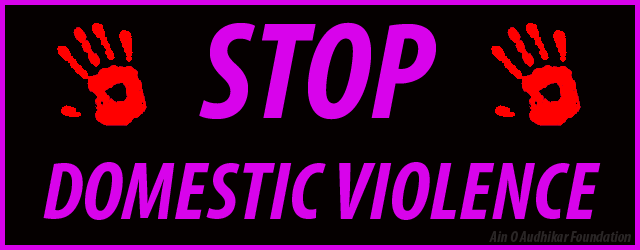Domestic Violence
Although Bangladesh has attained remarkable success in increasing literacy rates for woman and decreasing the maternal and child mortality rate, violence against women is still very high in our society among which domestic violence is widely prevalent in both urban and rural areas as on every day matter of women lives.
A study by ICDDRB in 2006 indicated that 60% of violence suffered by women occurs within their home. The 5th Bangladesh Demographic and Health Survey, (BDHS) 2007 showed 53% of women experienced sexual or physical violence from husbands.
Being vulnerable in a patriarchal society, women face various types of domestic violence in Bangladesh. In a recent study (Centre for Policy Dialogue, 2009) it has been observed that mainly four types of domestic violence occur, i.e. physical, psychological, economic and sexual and sexual abuse and violence; all are prevalent throughout Bangladesh. Most of the victims (93%) reported in the study that they had experienced physical violence; only 13% reported of having experience of sexual violence, 92% of victims reported economic violence and 84% reported psychological violence committee by their husbands.
Occurrence of domestic violence varies little in terms of urban-rural divide. A ICDDR,B study shows that among ever-married women, 40% of those in the urban area and 42% in the rural area reported physical violence by their husband (ICDDR,B,2066). However, sexual violence by husband is more prevalent in rural areas (50%) than urban areas (37%), according to the study.
We often focus on grave social and health impact of domestic violence as it creates social instability, insecurity and gender disparity. But the economic impact is immense, which remains unseen most of the time. A care study shows that domestic violence costs 2.05% loss of Bangladesh’s Gross Domestic Product (GDP) worth around Tk.15 crore annually.
The amount is equal to the sum spent by the government in the health and nutrition sector, said the study conducted on 483 such women victims from January to June in 2010 villages of Dinajpur, Tangail and Sunamganj.
Most domestic violence involves male anger directed against their women partners. Cross-cultural studies of wife abuse have found that nearly a fifth of peasant and small-scale societies are essentially free of family violence. The existence of such cultures proves that male violence against women is not the inevitable result of male biology or sexuality, but more a matter of how society views masculinity.
The causes of domestic violence identified range from sexual inequality within a patriarchal system, poverty and a lack of understanding of women’s rights to, alarmingly, corruption within the justice system. Many cases of domestic violence go unreported; the majority of them are not brought to court; few are awarded convictions.
The WHO Multi-country study on Women’s Health and Domestic Violence against Women (2005) showed that less than 1% of physically abused women reported the matter.
It is a matter of concern that a culture of acceptance even, has grown and is being transmitted from generation to generation to the point of being institutionalised. A study of BNWLA shows that 30% of women think that husbands have the “right” to inflict physical violence upon their wives.






